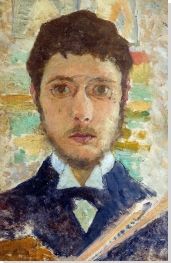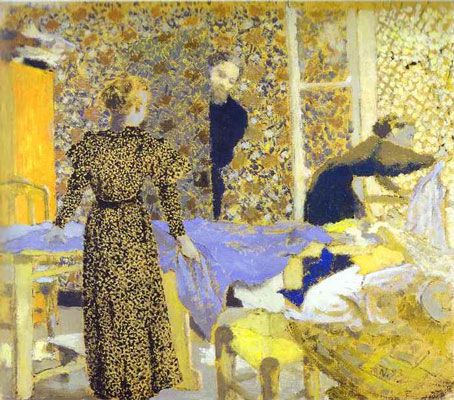Summary of Pierre Bonnard
Pierre Bonnard was a member of the Symbolist group of painters known as Les Nabis ("prophets" or "seers"), and so subscribed to the Nabi doctrine of abandoning three-dimensional modeling in favor of flat color areas. However, although Bonnard was a member of this group, he was not interested in obscure Symbolist subject matter and was not a mystic. Instead, he was satisfied - even fascinated and delighted by - the scenes of simple daily life around him. Because of this, he has been called an "intimist."
Accomplishments
- For Bonnard, color was an end in itself - a way of experiencing the world. Color was so important to Bonnard that when he had mixed a color that was particularly to his liking, he would even go back and touch up other paintings with that color. He once persuaded his friend Édouard Vuillard to distract one of the guards in a museum while he touched up a work that had been completed years previously.
- Bonnard painted many of his scenes from memory, capturing the spirit of the moment rather than the exact person or place. Bonnard did not paint from life but rather drew his subjects - sometimes photographing them as well - and made notes on the colors. He then painted - and especially, colored - the canvas in his studio from his notes.
- Bonnard also designed furniture, developed textile patterns, painted screens, created stage sets, made puppets for puppet shows, and illustrated books. Though he is most noted for his paintings, these additional activities also situate him squarely within that part of Nabi art that applied their aesthetic to other art forms; this aspect of his practice reflects both that period's interest in the decorative as a way to unify the environment through largely abstract means and artists' interest in serving the needs of public spaces, including the burgeoning field of advertising.
Important Art by Pierre Bonnard
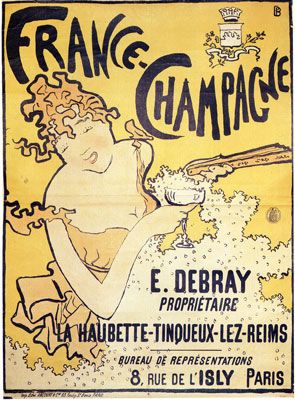
France Champagne
This lithograph launched Bonnard's career from law into art; in 1889, he won a competition to design a poster advertising France Champagne, which led him to create this illustration. A seemingly frivolous female looks over her shoulder, holding a fan in one hand and her magical glass of champagne in the other. There is a witty play on the oneness of the young girl with the bubbles of champagne. Champagne bubbles, expressed through an agitated line that alternates between thick and thin, create both a literal and symbolic feeling of froth. The bubbles engulf the woman and she becomes part of the total pattern. The "C" of the word "Champagne" relates visually to the arc of her arm such that compositional elements reinforce the gaiety of the woman and of champagne itself. The work is characterized by continuous, undulating outlines, flattened form, flat poster color, distorted perspective and proportion, purposeful distortion of perspective and proportion, and the elimination of detail and decoration. The influences of Japanese prints is visible here and, perhaps even more so, that of Jules Cheret's prints. France Champagne, which was to influence Henri de Toulouse-Lautrec, is an early expression of the Art Nouveau aesthetic as well as an early use of the pretty girl to advertise a product.
Lithograph - Bibliothèque Nationale, Paris
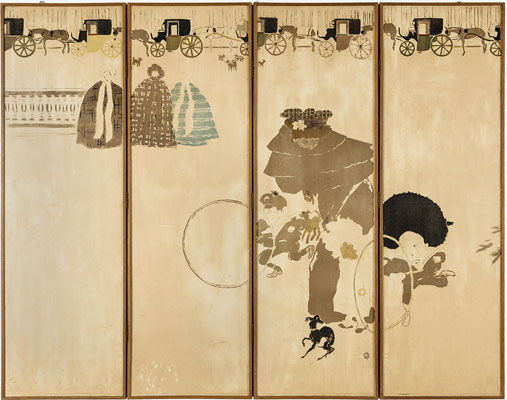
Promenade des nourrices, fries des fiacres (Nannies Promenade, Frieze of Carriages)
This four-paneled work is characterized by its understatement, economy of line, and rhythm. Bonnard places his figures asymmetrically and balances them against the empty space. The decorative use of silhouette is influenced by both the Art Nouveau style and of Japanese prints. Bonnard here employs a great economy of means - accomplishing many effects with only a few elements. An example of this would be the way the artist lets white function in multiple ways: it fills in the faces and it is worked into the figures' costumes. The animated linear arabesque of the dog functions in such a way as to suggest volume. Through the distortion of form for decorative effect, Bonnard has created a world of decorative unreality that asserts the two-dimensionality of the wall, thus uniting art and architecture.
Color lithograph - Musée d'Orsay, Paris
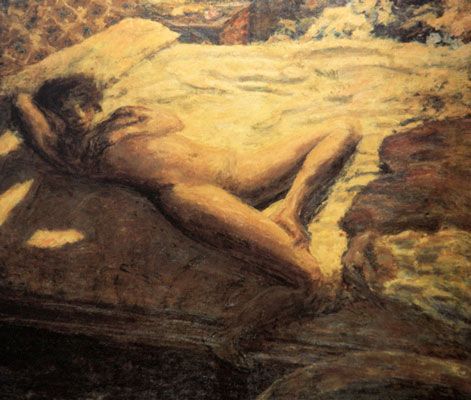
Woman Reclining on a Bed
This painting is a good example of Bonnard embedding his figure within an intimate surrounding. The artist employs a corner point of view from which we are allowed to view the figure, whose face is concealed in shadow. The brushwork is similar to that of the Impressionists, but the artist has created more of an intimate, moody atmosphere - almost an erotic one - with the viewer as voyeur. Furthermore, this is not the monumental or idealized nude that one might recognize from a Titian or Rubens: this nude distinguishes itself from other nudes of the time in its natural pose and lack of inhibition. In fact, Bonnard is often credited with the introduction of this "modern" nude.
Oil on canvas - Musée d'Orsay, Paris
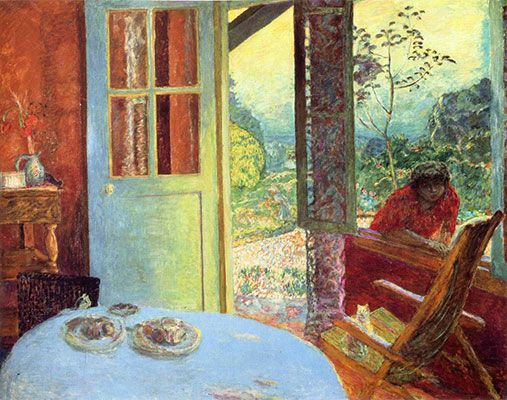
Dining Room in the Country
Bonnard was fascinated with different levels of perspective and with the tricks of perspective. In this painting there are no real space-defining objects - the chair and the washstand blend into the wall. The composition is a "corner composition," moving diagonally across the table, treated as a vertical plane, through the doorway to the woman to the landscape. Then there is a cross-diagonal movement through the chair to the washstand. This spatial movement is largely dependent on color; color is the primary director of this painting. Our eye is carried from the indoors to the outdoors via the red color. The door is the same color as the landscape, the table, and the crockery. Bonnard also contrasts the warm orange-red colors of the interior and the cool whites of the outdoors - a contrast accompanied by a heightened quality of the light.
Typically, Bonnard's figures appear less psychologically complex than the figures of Vuillard. As in this painting, the figure seems withdrawn - functioning as a mere prop - and is, in fact, psychologically recessive. That she seems to lack tangibility and psychological presence is borne out of the fact that although she is outdoors, the artist has placed her within a shadow and painted her in the same color as the interior wall. Bonnard is less interested in the specificity of the person, and instead, sets up a very complex spatial organization emphasizing that which is indoors and that which is outdoors, thus heightening Impressionist color and harnessing it to the service of linking figure to environment rather than recording a specific time of day. As is characteristic of the artist's work, the emphasis is on embedding the figure into the sensuous environment of both the depicted scene and the painted reality.
Oil on canvas - Minneapolis Institute of Art
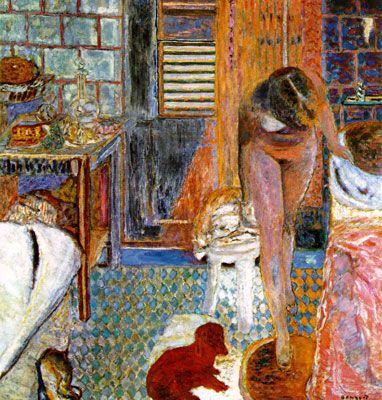
The Toilet
Bonnard's bathroom and environs are known to have been very simple, plain, and functional. But in Bonnard's numerous bath scenes, spaces and objects have their own mystery and mood. Locked in her environment, the figure (Madame Bonnard) - the un-idealized, "modern" nude - is at one with her surroundings. It is an intimate scene in both subject matter, and the way the light caresses the objects, exposes their surfaces and highlighting the contours of the flesh. In contrast to his earlier fin-de-siècle work, the artist reanimates the space and gives depth to the scene, using tiles to shape it and modeling objects to make them appear more sensuous and tangible. As is usual in Bonnard's work, color creates the dominant effect, as the artist manipulates the oranges of the body and floor and the mauve of the wall and the legs to produce an aesthetically pleasing effect. Bonnard also uses luminous colors to produce a sensuous effect - a kind of nostalgic recollection of beauty and of the mystery of life. Since Bonnard is known to have worked largely from memory, this would be recollection at a distance, with objects taking on psychological qualities. Some of Bonnard's bath scenes even recall passages in Marcel Proust's Remembrance of Things Past (1913). Several influences present themselves here, beginning with that of the 17th-century Dutch painter Johannes Vermeer in the rectilinear division of the surface and in the mosaic of sumptuous color that celebrates the little pleasures of life. The influence of Renoir's colors, brushwork, and heavy coloristic atmosphere is likewise evident. In fact, the painting would almost seem an Impressionist capturing of sunlight, except that the colors are more arbitrary and the space more compartmentalized than that of the Impressionists. Bonnard very carefully selects those objects upon which he wishes the viewer to focus. Some objects are intentionally out of focus, and some are intentionally in focus. Sometimes the figures even take a back seat to the objects. Rather than attempting the spontaneity of Impressionism, here Bonnard paints a figure performing a kind of habitual action - a figure in frozen permanence brought to mind through the act of memory acted upon by feeling.
Oil on canvas - Private Collection
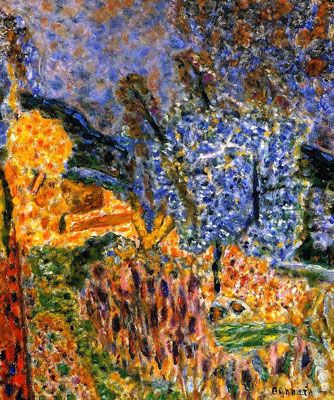
Landscape at Le Cannet
Without the title, one might read this painting as being totally abstract, emphasizing as it does the flat surface of the painting rather than any depth of landscape. Its brushy shape areas are reminiscent of the work of Gauguin. Bonnard's treatment of this landscape in the south of France reminds us that shape does not have to be seen with an outline around it; shapes can be read as mere changes of color as we see here. Painted just two years before his death, this painting serves as an example of Bonnard's late work and follows the stylistic trajectory of increasing abstraction similar to that of late Monet and the Impressionists. Furthermore, it is fitting close to his earlier association with the group of Les Nabis. Bonnard took Maurice Denis's words further than any other member of this group: "Remember, that a picture, before it is a picture of a battle horse, a nude woman, or some story, is essentially a flat surface covered in colors arranged in a certain order."
Oil on canvas - Musée Bonnard, Le Cannet
Biography of Pierre Bonnard
Childhood and Education
Bonnard was born in Fontenay-aux-Roses, Hauts-de-Seine, on October 3, 1867. He was the son of a prominent official of the French Ministry of War, and upon the insistence of his father, Bonnard studied law at the Sorbonne from 1885 to 1888. He graduated with a Baccalaureate, distinguishing himself in the Classics, and briefly practiced as a barrister in a government office. However, he had also attended art classes at the École des Beaux-Arts, where he failed to win the Prix de Rome (which would have allowed him to study at the French Academy in Rome), and so transferred to the Académie Julian in 1889, where he met Maurice Denis, Paul Sérusier, Ker-Xavier Roussel, Paul Ranson, Félix Vallotton, and Édouard Vuillard. He soon decided to become an artist, and in 1890 shared a studio in Montmartre with Denis and Vuillard. Later they were joined by theatrical producer Aurélian Lugné-Poe with whom Bonnard collaborated on productions for the Théâtre de l'Oeuvre in Paris.
Thus, still in his twenties, Bonnard joined Les Nabis, a group of young artists committed to creating work of a symbolic and spiritual nature. His friends nicknamed him a "highly Nipponized Nabi" in reference to the Japanese prints that influenced him. This influence of Japonism had also been ascribed to the work of the Impressionists and Post-Impressionists.
Mature Period
In 1891, Bonnard met Henri de Toulouse-Lautrec and began showing his work at the annual exhibition of the Société des Artistes Indépendants. In the same year, Bonnard also began his association with La Revue Blanche for which he and his friend Vuillard designed frontispieces. His lithographs were published in 1895 by the well-known art dealer Ambroise Vollard, and the same year he designed a stained glass window for Louis Comfort Tiffany. His first one-person show was at Galerie Durand-Ruel in 1896. He illustrated poet Paul Verlaine's book of Symbolist poems Parallèlement in 1900. Around this time, he painted landscapes in the style of the Impressionists and Paul Gauguin in the countryside between Paris and Normandy.
In 1907, Bonnard traveled extensively though Europe and North Africa, although these excursions seemed not to have affected his art to any great extent. He left Paris in 1910 for the south of France. Aside from a few war-themed sketches, there are no traces of the war's effect on his art either. Bonnard was described by historians and his own friends as a man of "quiet temperament," and one who was unobtrusively independent. His often complex compositions - typically of sunlit interiors of rooms and gardens populated with friends and family members - are both narrative and autobiographical.
His wife Marthe de Méligny, whom he had met in 1893, was an ever-present subject over the course of several decades. It was not until they married 32 years later in 1925 that Bonnard became aware that her real name was Maria Boursin. It is said that she ran away from her home and lied about her age and status for many years. Nevertheless, she became the (sometimes) obsessive subject of his work, with him painting her as many as 385 times. He also took intimate photos of her that he would later incorporate into his paintings.
He also painted several self-portraits, landscapes, street scenes, and many still lifes depicting flowers and fruit. His habit was to work on numerous canvases simultaneously, which he tacked onto the walls of his small studio; in fact, Bonnard had one of the smallest studios in the history of modern art. In this way he could more freely determine the shape of a painting: as he noted, "it would bother me if my canvases were stretched onto a frame. I never know in advance what dimensions I am going to choose."
Late Period and Death
In 1926, Bonnard had moved to Le Cannet near Cannes in the south of France. In his old age, he returned to the dazzling light and color of his earlier work. In 1938, there was a major exhibition of his work along with Vuillard's at the Art Institute of Chicago. During World War II, he maintained his residence in Le Cannet, continuing there as a recluse even after his wife died in 1942. Shortly before his death he completed the large mural Saint Francis Healing the Sick (1947) for the Church of Assy. He finished his last painting, The Almond Tree in Blossom (1947), a week before his death in his cottage on La Route de Serra Capeou near Le Cannet on the French Riviera. The Museum of Modern Art in New York organized a posthumous retrospective of Bonnard's work in 1948, although originally it was meant to be a celebration of the artist's 80th birthday. Although Bonnard avoided public attention, his work sold well during his life.
The Legacy of Pierre Bonnard
At the time of his death, Bonnard's reputation had already been eclipsed by subsequent avant-garde developments in the art world. Reviewing a retrospective of Bonnard's work in Paris in 1947, the critic Christian Zervos assessed the artist in terms of his relationship to Impressionism and found him wanting: he noted, "in Bonnard's work Impressionism becomes insipid and falls into decline." Henri Matisse responded by saying; "I maintain that Bonnard is a great artist for our time and, naturally, for posterity." Thus, Bonnard has often been identified as a late Impressionist, but this label falls short of his contributions to painting. Bonnard's work is, rather, characterized by a unique use of color that enriched and heightened the Impressionist palette. His use of overlapping planes of color seems even to prefigure the Cubists' use of planes penetrating one another.
Bonnard has also been cited for his unique expression of wit in and through painting. In a 2009 review of Bonnard in The New Republic, Jed Perl saw in Bonnard's work a "quality that might be characterized as perceptual wit - an instinct for what will work in a painting. Almost invariably he recognizes the precise point where his voluptuousness may be getting out of hand, where he needs to introduce an ironic note. Bonnard's wit has everything to do with the eccentric nature of his compositions. He finds it funny to sneak a figure into a corner, or have a cat staring out at the viewer. His metaphoric caprices have a comic edge, as when he turns a figure into a pattern in the wallpaper. And when he imagines a basket of fruit as a heap of emeralds and rubies and diamonds, he does so with the panache of a magician pulling a rabbit out of a hat."
Influences and Connections

-
![Ambroise Vollard]() Ambroise Vollard
Ambroise Vollard ![Felix Feneon]() Felix Feneon
Felix Feneon
Useful Resources on Pierre Bonnard
- Pierre BonnardOur PickBy Evelyn Benesch, Ulf Kuster, Pierre Bonnard
- Pierre Bonnard: Early and LateOur PickBy Elizabeth Hutton Turner, Pierre Bonnard, Nancy Wolsk
- Interpreting Bonnard: Color and LightBy Nicholas Watkins
- Pierre Bonnard: The Work of Art, Suspending TimeBy Yves-Alain Bois, Pierre Bonnard
- Pierre Bonnard: The Late Still Lifes and InteriorsBy Dita Amory, Jack Flam, Rémi Labrusse, Jacqueline Munck, Rika Burnham
 Ask The Art Story AI
Ask The Art Story AI